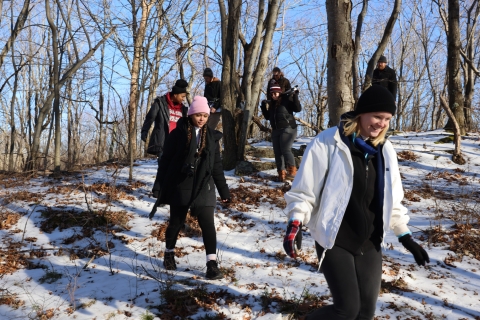A short drive from New York City, heading north along the Connecticut border, the Cranberry Mountain Wildlife Management Area encourages visitors to escape busy towns nearby to explore quiet forests and rolling hills. A few months from now, an integral parcel of land in the town of Patterson, Putnam County, New York, will be added to this area thanks to the Westchester Land Trust and the New York Department of Conservation, with the assistance of the Highlands Conservation Act (HCA) grant program.
The U.S. Fish and Wildlife Service's HCA program supports land conservation in the Highlands region, which spans 3.4 million acres from Connecticut to Pennsylvania. This source of federal funding helps sustain wildlife habitat and natural benefits such as clean water and public recreation opportunities.
“This property has given us encouragement, energy, and confidence for future projects up here on the Cranberry Mountain corridor,” said Brendan Murphy, director of stewardship for the Westchester Land Trust.
Murphy said Cranberry Mountain WMA is one of the largest blocks of protected open space in the area, but there was something missing.
He said there was a “gap” between the Cranberry Mountain WMA and Putnam County’s Michael Ciaiola Conservation Area. The addition of the Schein property will bridge that gap and complete the circle between the parcels.
“It means a lot that this property will be preserved,” Murphy said. “It serves as a core linkage. Before, it was a U-shaped corridor, now this forms a permanent east to west connection.”
Murphy describes how the diverse property will benefit visitors and support many species of wildlife.
“From a nice stream on the east side with some small plunge pools and waterfalls, this property is within the drinking water supply watershed for New York City,” he said. “Also, there is an old hemlock forest, which I always really appreciate. Underneath that hemlock forest there are some sensitive wildflowers and ferns, which we didn’t expect to see there. It has particularly nice wetlands as well with some thickets of native winterberry. Right where we’re standing here it has blueberry understory, which is great cover for wildlife.”
Nathan Ermer, regional program manager for the New York State Department of Environmental Conservation, said the property will contribute to water quality protection and provide quality of life benefits for nearby urban areas. In addition to being a wildlife management area wildlife management area
For practical purposes, a wildlife management area is synonymous with a national wildlife refuge or a game preserve. There are nine wildlife management areas and one game preserve in the National Wildlife Refuge System.
Learn more about wildlife management area , the parcel will offer public recreation opportunities which may include hiking, nature observation, bird watching, hunting, trapping, and cross-country skiing.
Ermer said Cranberry Mountain WMA is located approximately one hour north of New York City. This area is densely populated, and large parcels of open land can be expensive and difficult to conserve.
“The Highlands Conservation Act is a source of federal funding that we’re able to access for projects in the designated Highlands area of New York. It provides leverage for us to justify prioritizing projects in this area of the state,” Ermer said. “The grant program provided us with the financial resources that allowed us to prioritize this acquisition.”
The proximity to urban areas will allow many people to take part in recreational use of this area for years to come. The diverse landscape, drinking water resources, and wildlife habitats come together to form a valuable parcel of conserved land that will serve the surrounding area today and for future generations.
“It’s a rural landscape in a suburban ocean,” said Ermer, who explains the many benefits of living near open space include water quality protection, quality of life benefits, and wildlife habitat protection. “The other benefit is for public recreation. Our proximity to the New York metropolitan area means that there are a lot of New Yorkers and visitors from adjoining states that are looking for places to get outside and enjoy nature. That is something that this area certainly will provide.”





